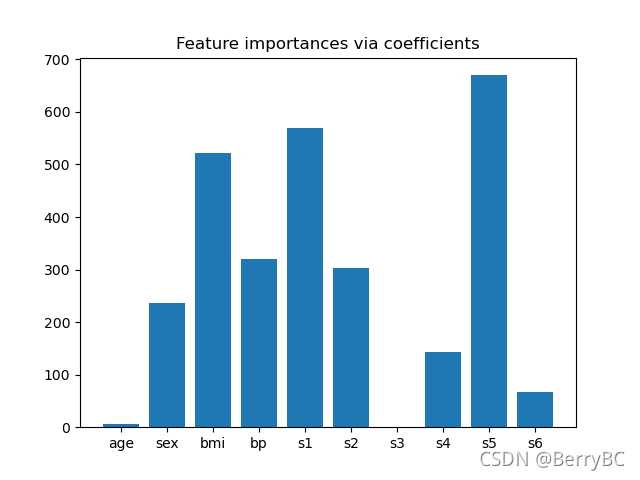基于模型和顺序特征选择 - Model-based and sequential feature selection
Model-based and sequential feature selection
基于模型和顺序特征选择
此示例说明并比较了两种特征选择方法:基于特征重要性的 SelectFromModel 和依赖于贪婪方法的 SequentialFeatureSelection。
我们使用了有442个病人的数据,其中每个病人有10个特征值。
Authors: Manoj Kumar (mks542@nyu.edu) , Maria Telenczuk, Nicolas Hug.
License: BSD 3 clause
print(__doc__)
读取数据
我们首先加载 scikit-learn 中可用的糖尿病数据集,并展示其描述:
from sklearn.datasets import load_diabetes
diabetes = load_diabetes()
X, y = diabetes.data, diabetes.target
print(diabetes.DESCR)
.. _diabetes_dataset:
Diabetes dataset
----------------
在基准时间上测量的十个变量:年龄、性别、体重指数、平均血压,
以及442名糖尿病患者,在基准时间后一年疾病进展的定量测量。
**Data Set Characteristics:**
:Number of Instances: 442
:Number of Attributes: First 10 columns are numeric predictive values
:Target: Column 11 is a quantitative measure of disease progression one year after baseline
:Attribute Information:
- age age in years
- sex
- bmi body mass index
- bp average blood pressure
- s1 tc, total serum cholesterol
- s2 ldl, low-density lipoproteins
- s3 hdl, high-density lipoproteins
- s4 tch, total cholesterol / HDL
- s5 ltg, possibly log of serum triglycerides level
- s6 glu, blood sugar level
Note: Each of these 10 feature variables have been mean centered and scaled by the standard deviation times `n_samples` (i.e. the sum of squares of each column totals 1).
Source URL:
https://www4.stat.ncsu.edu/~boos/var.select/diabetes.html
For more information see:
Bradley Efron, Trevor Hastie, Iain Johnstone and Robert Tibshirani (2004) "Least Angle Regression," Annals of Statistics (with discussion), 407-499.
(https://web.stanford.edu/~hastie/Papers/LARS/LeastAngle_2002.pdf)
重要特征的系数
为了了解特征的重要性,我们将使用 LassoCV 估计器。具有最高绝对 coef_ 值的特征被认为是最重要的。我们可以直接观察系数而无需缩放它们(或缩放数据),因为从上面的描述中,我们知道这些特征已经标准化了。有关线性模型系数解释的更完整示例,您可以参考线性模型系数解释中的常见缺陷。
import matplotlib.pyplot as plt
import numpy as np
from sklearn.linear_model import LassoCV
lasso = LassoCV().fit(X, y)
importance = np.abs(lasso.coef_)
feature_names = np.array(diabetes.feature_names)
plt.bar(height=importance, x=feature_names)
plt.title("Feature importances via coefficients")
plt.show()

根据重要性选择特征
假设现在我们要根据系数选择最重要的两个特征。 SelectFromModel 仅用于此目的。 SelectFromModel 接受阈值参数并将选择重要性(由系数定义)高于此阈值的特征。
由于我们只想选择 2 个特征,因此我们将此阈值设置为略高于第三个最重要特征的系数。
from sklearn.feature_selection import SelectFromModel
from time import time
threshold = np.sort(importance)[-3] + 0.01
tic = time()
sfm = SelectFromModel(lasso, threshold=threshold).fit(X, y)
toc = time()
print("Features selected by SelectFromModel: "
f"{feature_names[sfm.get_support()]}")
print(f"Done in {toc - tic:.3f}s")
Features selected by SelectFromModel: ['s1' 's5']
Done in 0.048s
使用顺序特征选择选择特征
另一种选择特征的方法是使用 SequentialFeatureSelector (SFS)。 SFS 是一个贪婪的过程,在每次迭代中,我们根据交叉验证分数选择最好的新特征添加到我们选择的特征中。也就是说,我们从 0 个特征开始,选择得分最高的最好的单个特征。重复该过程,直到我们达到所需的所选特征数量。
我们也可以反其道而行(backward SFS),即从所有特征开始,贪婪地选择特征一一去除。我们在这里说明了这两种方法。
from sklearn.feature_selection import SequentialFeatureSelector
tic_fwd = time()
sfs_forward = SequentialFeatureSelector(lasso, n_features_to_select=2,
direction='forward').fit(X, y)
toc_fwd = time()
tic_bwd = time()
sfs_backward = SequentialFeatureSelector(lasso, n_features_to_select=2,
direction='backward').fit(X, y)
toc_bwd = time()
print("Features selected by forward sequential selection: "
f"{feature_names[sfs_forward.get_support()]}")
print(f"Done in {toc_fwd - tic_fwd:.3f}s")
print("Features selected by backward sequential selection: "
f"{feature_names[sfs_backward.get_support()]}")
print(f"Done in {toc_bwd - tic_bwd:.3f}s")
Features selected by forward sequential selection: ['bmi' 's5']
Done in 3.271s
Features selected by backward sequential selection: ['bmi' 's5']
Done in 9.821s
讨论
有趣的是,前向和后向选择选择了相同的特征集。一般来说,情况并非如此,两种方法会导致不同的结果。
我们还注意到,SFS 选择的特征与特征重要性选择的特征不同:SFS 选择 bmi 而不是 s1。不过,这听起来确实合理,因为根据系数,bmi 对应于第三个最重要的特征。考虑到 SFS 根本不使用这些系数,这是非常了不起的。
最后,我们应该注意到 SelectFromModel 比 SFS 快得多。事实上,SelectFromModel 只需要拟合一个模型一次,而 SFS 需要为每次迭代交叉验证许多不同的模型。然而,SFS 适用于任何模型,而 SelectFromModel 需要底层估算器来公开 coef_ 属性或 feature_importances_ 属性。前向 SFS 比后向 SFS 更快,因为它只需要执行 n_features_to_select = 2 次迭代,而后向 SFS 需要执行 n_features - n_features_to_select = 8 次迭代。
源代码如下: Download Python source code: plot_select_from_model_diabetes.py
Download Jupyter notebook: plot_select_from_model_diabetes.ipynb